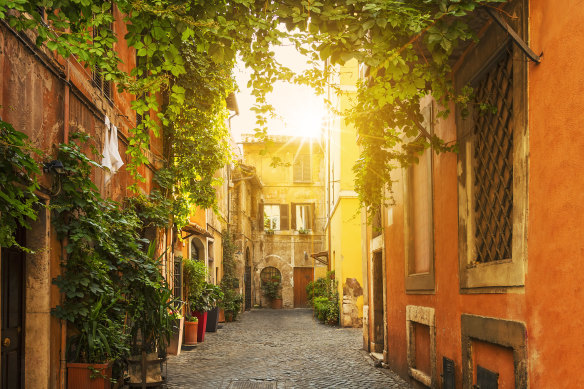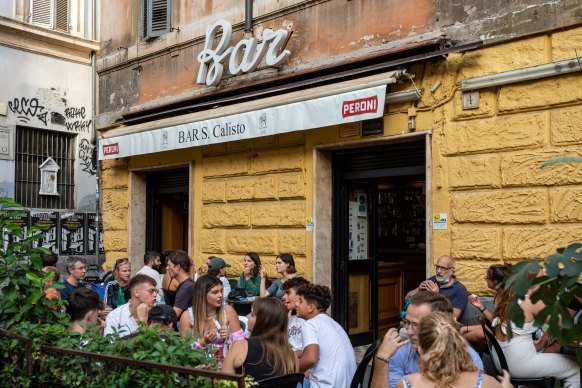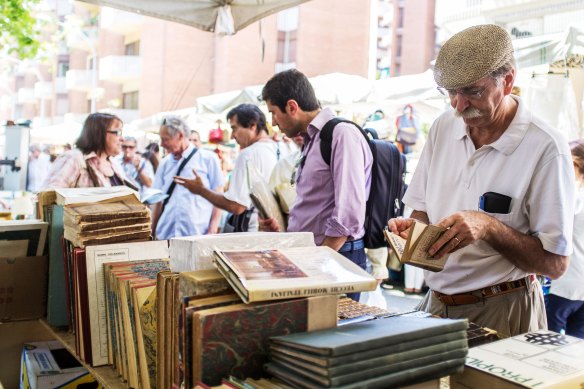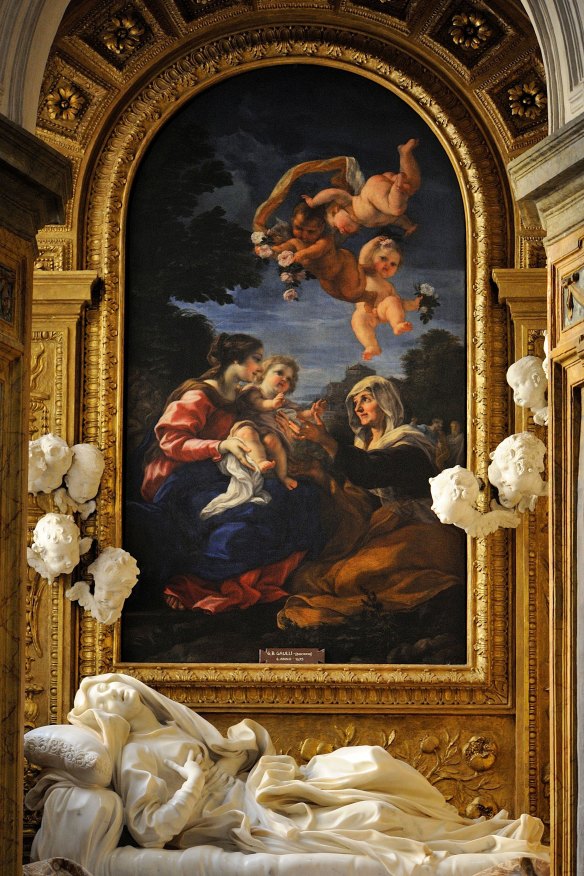This was published 1 year ago
The secret to finding la dolce vita? Staying in the same place for a month
The sweetest staycation: setting up a home base for four weeks in the heart of Rome’s Trastevere neighbourhood.
By Barry Divola

One of Trastevere’s cobblestone streets.Credit: Getty Images
Whenever I travel, if I’m lucky, I experience what I call “the moment”. It happened while hitchhiking as a backpacker near Loch Ness in 1986; while pounding the pavements of New York’s East Village, slightly drunk and entirely besotted, in 1991; while getting hopelessly and wonderfully lost in the labyrinthine alleyways of Marrakesh in 2010; and, less than a year ago, while navigating the back streets of Harajuku at night, as jetlagged as Bill Murray in Lost In Translation, a full moon casting an otherworldly glow and prompting a strange sense of déjà vu that gave me a warm feeling in my chest.
And when I have those moments, I stop in my tracks, smile to myself and say under my breath: “Remember this.”
Last year I spent the entire month of April in Rome with my wife and two young daughters, and those moments just kept on coming.
I think a lot of it had to do with the fact we decided to stay in one place for four weeks, rather than cramming in as many cities as we possibly could, packing up every three or four days to catch another train, another plane, another chance to stress out and risk meltdowns, arguments or divorce.
By our second week, we’d hit that sweet spot where we knew we had plenty of time to immerse ourselves in everything Rome had to offer without worrying about time constraints – we were truly living la dolce vita.

Local haunt Bar San Calisto, which has been around since 1969.Credit: Alamy
We rented an old two-bedroom apartment in Trastevere, a neighbourhood across the Tiber river from the bustling Centro Storico, which is so Roman it’s almost like a film set – narrow cobblestone streets that spill into piazzas with fountains in the centre, ochre-coloured apartment buildings with ivy crawling the walls and washing hanging on lines from the windows, while Vespas cruise past and people laze over tiny cups of coffee or Aperol Spritzes at streetside cafe tables.
We learnt the joy of la passeggiata, strolling for sheer pleasure.
My mornings began with the sound of metal shutters being rolled up as the fruit and vegetable vendors started setting up their stalls for the day on our square, Piazza di san Cosimato. I grew to love that sound as much as birdsong. We would walk to nearby Bar San Calisto, a cafe/bar that seemed frozen in time from 1969, when it opened. We came to know the regulars and we nicknamed them – Flat Cap was an old guy who took up residence at a table by the window each morning and systematically read every page of the daily paper; The Artist was a birdlike woman who sat in a corner, opened a wooden box and sorted through her water-colours and brushes for the day; Top-Knot was a man-bunned dude in leather jacket and wraparound sunglasses, who was there at seven in the morning and still there at midnight. Then there was The Silver Fox, a trim, well-preserved gent who jovially greeted the staff each morning in chirpy Italian and downed a few cups of espresso on the terrace.
One morning my wife came back to our table after ordering and said, “The Silver Fox is Australian! I heard him talking to a young couple outside.” The following day I said hello. He was a retired chartered accountant from Sydney, spending three months living in Rome. It turned out we used to live on the same block in Kings Cross.
We learnt the joy of la passeggiata, strolling for sheer pleasure without a definite destination in mind. We lost ourselves in the charming vicoli (“little streets”), climbed Janiculum Hill past a carousel and a puppet theatre for the most stunning view of the city, wandered the sprawling Porta Portese market each Sunday morning, and ate gelato every single day.

The sprawling Porta Portese market is a Sunday ritual for Rome’s locals and tourists.Credit: Alamy
Wherever you go around the world, there are plenty of people to tell you that everything has changed and you should have been there 10 or 20 years ago. Trastevere is no exception. Yes, it’s now much more heavily touristed. Yes, restaurants have taken over many of the shopfronts. Yes, there are a couple of American universities here and the place has a lot of expats. But so what? I like the attitude of Leo, who owns a vintage guitar store on our block and has been there for a quarter-century.
“Things have changed, but it’s still Trastevere,” he says with a shrug, lighting up a cigarette behind his counter, because despite the world changing, people still smoke indoors here. “Everything changes. I change all the time. I’ve changed places where I live. I’ve changed jobs. I’ve changed wives. But I’m still me.”
And Trastevere is still Trastevere. On our return home, I watched a 1971 film set in the neighbourhood and, apart from the rats and horse-drawn carts in the streets back then, the place didn’t look very different. The opening credits even featured a long-shot of Piazza di san Cosimato, and I could see our apartment.

The Blessed Ludovica Albertoni sculpture by Bernini, and painting by Baciccio, at the Church of San Francesco a Ripa.Credit: Alamy
On our last day in Rome, I woke up early and couldn’t get back to sleep, so I went out and walked the quiet streets as day dawned. That week I’d read a short story by Francesco Mandica about a 60-year-old woman who had lived a quiet married life of denial. While on holiday in Rome, she walks into the Church of San Francesco a Ripa and has a revelatory moment with a Bernini sculpture that features a Roman noblewoman in the throes of ecstasy – whether it’s religious or human ecstasy has long been up for debate.
I discovered the church was in Trastevere, so went looking for it. The statue turned out to be remarkable, possibly the most striking of the many artworks I saw in the previous four weeks. As soon as I walked back outside, the church bells started to toll, echoing around the square. A huge flock of pigeons fluttered past me and the sound of the rolling-up of metal shutters created a neighbourhood symphony.
And I felt it. The moment. I smiled to myself, stopped in my tracks and said under my breath: “Remember this.”
To read more from Good Weekend magazine, visit our page at The Sydney Morning Herald, The Age and Brisbane Times.